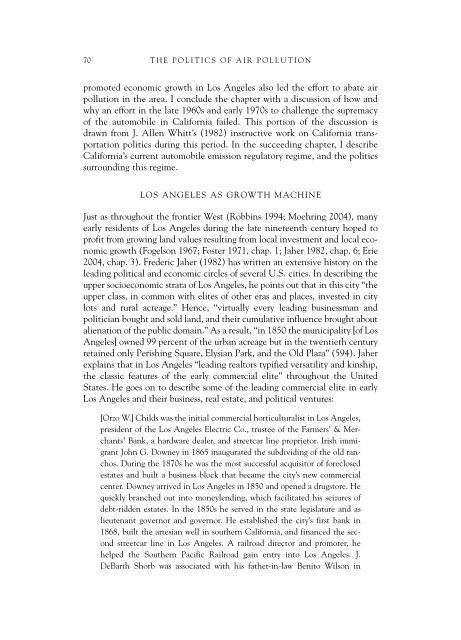GEORGE A. GONZALEZ - fieldi
GEORGE A. GONZALEZ - fieldi
GEORGE A. GONZALEZ - fieldi
Create successful ePaper yourself
Turn your PDF publications into a flip-book with our unique Google optimized e-Paper software.
70THE POLITICS OF AIR POLLUTIONpromoted economic growth in Los Angeles also led the effort to abate airpollution in the area. I conclude the chapter with a discussion of how andwhy an effort in the late 1960s and early 1970s to challenge the supremacyof the automobile in California failed. This portion of the discussion isdrawn from J. Allen Whitt’s (1982) instructive work on California transportationpolitics during this period. In the succeeding chapter, I describeCalifornia’s current automobile emission regulatory regime, and the politicssurrounding this regime.LOS ANGELES AS GROWTH MACHINEJust as throughout the frontier West (Robbins 1994; Moehring 2004), manyearly residents of Los Angeles during the late nineteenth century hoped toprofit from growing land values resulting from local investment and local economicgrowth (Fogelson 1967; Foster 1971, chap. 1; Jaher 1982, chap. 6; Erie2004, chap. 3). Frederic Jaher (1982) has written an extensive history on theleading political and economic circles of several U.S. cities. In describing theupper socioeconomic strata of Los Angeles, he points out that in this city “theupper class, in common with elites of other eras and places, invested in citylots and rural acreage.” Hence, “virtually every leading businessman andpolitician bought and sold land, and their cumulative influence brought aboutalienation of the public domain.” As a result, “in 1850 the municipality [of LosAngeles] owned 99 percent of the urban acreage but in the twentieth centuryretained only Perishing Square, Elysian Park, and the Old Plaza” (594). Jaherexplains that in Los Angeles “leading realtors typified versatility and kinship,the classic features of the early commercial elite” throughout the UnitedStates. He goes on to describe some of the leading commercial elite in earlyLos Angeles and their business, real estate, and political ventures:[Orzo W.] Childs was the initial commercial horticulturalist in Los Angeles,president of the Los Angeles Electric Co., trustee of the Farmers’ & Merchants’Bank, a hardware dealer, and streetcar line proprietor. Irish immigrantJohn G. Downey in 1865 inaugurated the subdividing of the old ranchos.During the 1870s he was the most successful acquisitor of foreclosedestates and built a business block that became the city’s new commercialcenter. Downey arrived in Los Angeles in 1850 and opened a drugstore. Hequickly branched out into moneylending, which facilitated his seizures ofdebt-ridden estates. In the 1850s he served in the state legislature and aslieutenant governor and governor. He established the city’s first bank in1868, built the artesian well in southern California, and financed the secondstreetcar line in Los Angeles. A railroad director and promoter, hehelped the Southern Pacific Railroad gain entry into Los Angeles. J.DeBarth Shorb was associated with his father-in-law Benito Wilson in









